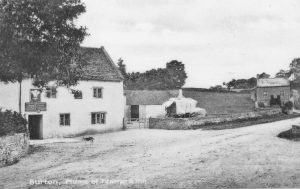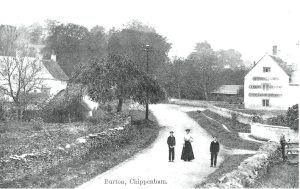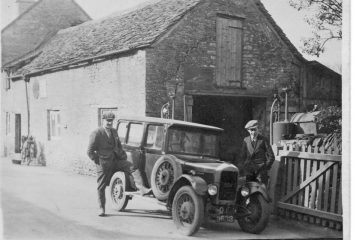Burton History: The Old Plume
Author: Chris Bennett
Introduction
The Bugle has been running a series of articles on the history of Burton, with a specific focus on villagers’ oral histories.
Here, we feature The Plume of Feathers public house, now the residential property, The Old Plume.
The Old Plume, Burton
After conducting some research into the history of the Plume of Feathers public house and receiving old photographs from village residents, we have been able to compile a quick snapshot of some of the history behind this lovely building. The below photograph isn’t dated, and we can only speculate on a period of time. However, the house in the background is believed to be Yew Tree Cottage, Marsh Lane, which later became a post office, and is thought to have been built in about the mid/late 18th century. Directly behind Yew Tree Cottage, you can just make out the rear of another building, which later became Marsh Lane Cottage and Bridleway Cottage.

The Plume of Feathers
The Plume of Feathers public house (believed to date back to 16th century) is situated on the main road through the village of Burton, a road linked to London and part of a network of historic routes over many centuries, some of which are linked to the stagecoach era of travel, which also began in England during the 16th century. Based on this tenuous connection we have included some details on how a ‘stagecoach’ operated.
In brief, a stagecoach is so called because it travels in segments or ‘stages’ of 10 to 15 miles. At a stage stop, usually a coaching inn, horses would be changed and travellers would have a meal or a drink, or stay overnight.
The first coaches were fairly crude and little better than covered wagons, generally drawn by four horses. Without suspension, these coaches could only travel at around 5 miles an hour on the rutted tracks and unmade roads of the time. During cold or wet weather, travel was often impossible.
The development of the stagecoach also had a big impact on the postal service. Introduced in 1635, riders carrying the mail rode between ‘posts’ where the postmaster would take the local letters and then hand the remaining letters and any new ones to the next rider. This system was less than perfect: the mail riders were often targeted by robbers and the delivery of the mail was slow.
It was therefore decided to introduce mail coaches to transport letters and parcels in a faster, safer and more efficient way. By 1797 there were forty-two coach routes throughout the country, linking most major cities and carrying both stagecoaches and mail coaches.
The Regency period saw great improvements in coach design and road construction, leading to greater speed and comfort for passengers. For example, in 1750 it took around 2 to 3 days to travel from Bristol to London but by 1820 the journey time had been slashed to under 12 hours.
However, the development of the railways in the 1830s had a huge impact on the stagecoach. Stage and mail coaches could not compete with the speed of the new railways. Soon the post was travelling by rail and by the mid 19th century, most coaches travelling to and from London had been withdrawn from service.
The Plume of Feathers public house was included in the sale of a large estate during 1839, which was leased at the time by Thomas and William Comly. Local census records during this period reveal a Comly family living in West Kington who were a farming family, although there is no definitive record to say they are one and the same families.
Records from archives of the Devizes and Wiltshire Gazette newspaper reveal the Plume of Feathers pub was used in the mid 19th century for numerous auctions of land, property and livestock.

The Plume of Feathers
The photograph above of The Plume of Feathers pub shows a trading connection with Dowding & Son brewery of Chippenham. On the opposite side of the road, we can see Bow Cottage and Dove Cottage. Records show this brewery was owned by Charles J Dowding from Marshfield and he had sons Frederick (bn. 1843) and Francis (bn. 1847). Francis inherited the Chippenham brewery following the death of his father in 1884. Brother Frederick was believed to be leasing the King William brewery in St Philip’s Bristol in 1875. Following a split with a business partner, Frederick set up the West Street brewery in Bedminster, Bristol. Unfortunately, in 1882, the business was liquidated and he later emigrated to New Zealand.
Dowding & Son, Chippenham Brewery, London Road was offered for auction on 10th June 1913 and bought by Wilkins Brothers & Hudson Ltd with 5 licensed houses, including The Plume of Feathers, Burton.
Wilkins Brothers & Hudson Ltd, Newtown Brewery was taken over by Usher’s Wiltshire Brewery Ltd in 1920 with 50 tied houses.
In May 1960 Usher’s Wiltshire Brewery Ltd. merged with Watney Mann Ltd and was re-named Usher’s Brewery Ltd in 1964.
The Plume of Feathers continued to trade as a public house until it was converted into a private dwelling house in 2000 and is now known as The Old Plume.
This blog was published previously as an article in The Bugle, as part of its Historical Burton series, and was written by Chris Bennett.


2 Comments
Neil · 08/20/2024 at 3:44 pm
Very interested to see the history of The Plume of Feathers, my parents used to run the pub around 1978 and we lived there for about 18 months.
Amanda Read · 08/20/2024 at 6:17 pm
Hi Neil,
Thank you for your comment. Do you have any memories you’d like to share of the property when it was a pub?